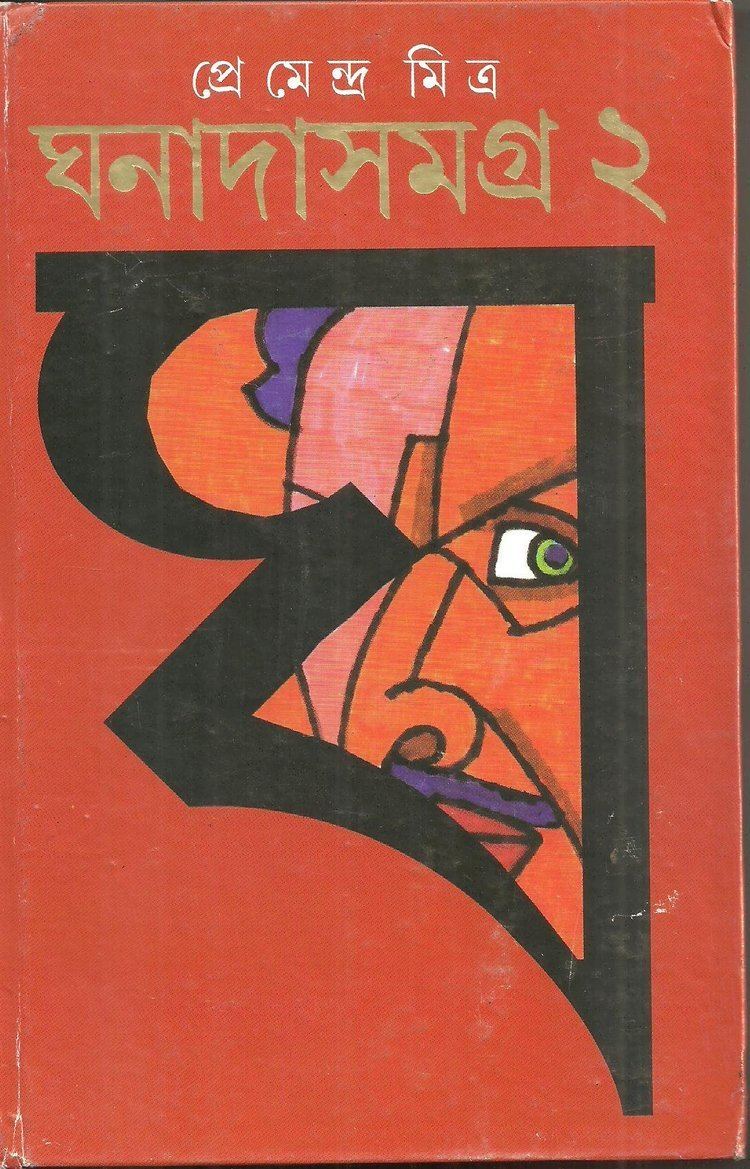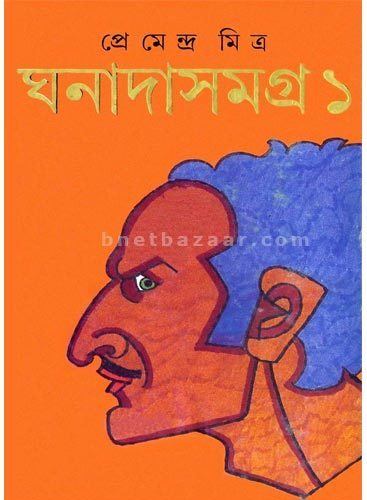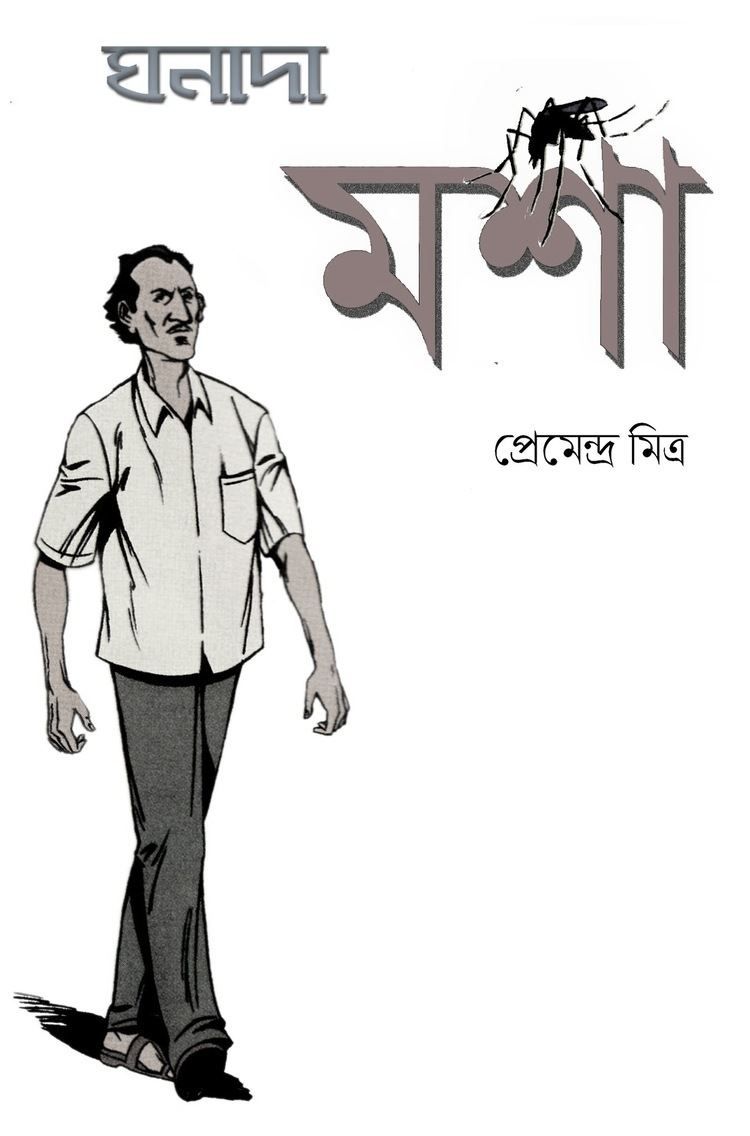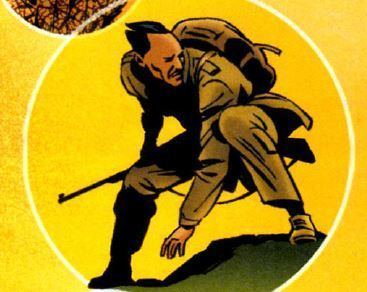Author Language Bengali Publication date First story on 1945 | Country India Publisher Various | |
 | ||
Genre Science Fiction, Adventure novel, Historical novel, Thriller Similar Tarini Khuro, Kakababu, Professor Shonku, Chacha Chaudhary, Tenida | ||
Ghanada (Bengali: ঘনাদা) is a fictional character in Bengali literature created by Premendra Mitra primarily for children and teenagers, though readers of all ages enjoys him. The suffix "da" behind the name "Ghana" commonly means elder brother in colloquial Bengali.
Contents
History

Ghanada is a middle-aged, tall and thin fictional character, who first appears in the short story Mosha, which was published in the Puja issue of Alpana (আলপনা) from Deb Sahitya Kutir publishers in 1945 (১৩৫২ in Bengali calendar). In the following Puja issues of several magazines, Nuri (1947), Poka (1948), Ghori (1948), Chhori (1949), Machh (1949) etc. were published. Mou-Kaa-Shaa-Bi-Sh Bawnaam Ghanada is the last story written in 1987 and published in the Puja issue of Kishor Jnan Bijnan monthly magazine in that year. In 1984, some Ghanada-fans founded the Ghanada Club at Mitra's residence at Kalighat, Kolkata. Siddhartha Ghosh (the writer of Jhantumama) suggested this club in Kishor Jnan Bijnan in 1983. Some other members of this club were Rabin Bal and Kinnar Roy.
Life of Ghanada

Most of the short stories and novel featuring Ghanada take place at the all-male mess on No. 72, Banamali Naskar Lane in Kolkata, West Bengal where the four young members of the mess Shibu, Shishir, Gour and Sudhir (the narrator) try to trick or please the middle-aged Ghanada in a variety of ingenious ways to force out his stock of unique stories that range from science-fiction, action/adventure to historical conspiracies. In most of his stories, Ghanada himself is the wonderfully wise and wily hero who travels all-round the globe to tackle sinister bad-guys and international conspiracies. Apart from these four, there are two minor recurring characters, Rambhuj the cook and Banowari the all-purpose butler of the mess; also sometimes, a few temporary members have come, such as: Bapi Datta, Sushil Chaki and Dhanu Choudhury . As in Feluda and Tenida, female characters are generally missing in these stories.

But besides the stories taking place in No. 72 Banamali Naskar Lane, Ghanada also features in a number of novels and stories set in regular evening meetings of elderly gentlemen on the side of the Kolkata Lake. In these Ghanada is referred to as Ghanashyam Babu (the suffix Babu in Bengali is similar in usage to the honorific "Mr." in English). The four listeners are: Harisadhan Babu, Shibapada Babu, Ramsharan Babu and Bhabataran Babu. The author's style and approach loses the casual sense and gains a more polished, serious and sarcastically formal aura. In these episodes Ghanada never takes on the mantle of a hero himself (as he does in No. 72 Banamali naskar lane), but instead he fashions his narratives on any one of his illustrious, swash-buckling ancestors. Ghanada's ancestors are shown (except one story) to have influenced highly important historical events like the fall of the Inca Empire or Shivaji's remarkable escape from Agra in Medieval India. Unlike the mess-time stories, these stories feature heroines and mature scenes while the latters do not. The Lake-side episodes of Ghanada were targeted at an adult reader-base and all these tales are included in Ghanada Samagra 3.
Reviews

The author, Premendra Mitra had said that he decided to start the Ghanada series to educate children and teenagers on various lesser-known facts and topics of science, history and geography. Mitra wrote in the preface of Ghanada Toshyo Toshyo Omnibus:

The mystery, thrill and surprise- whatever I fell myself in the world of science; to test whether I can share the flavour to the readers, I have sent Ghanada to the stage with a mixture of humor (…নিজে যা কিছু অনুভব করি বিজ্ঞানের জগতের সেই রহস্য রোমাঞ্চ বিস্ময়ের স্বাদ পাঠকদেরও কিছু দিতে পারি কিনা দেখবার জন্যেই একটু কৌতুকের সুর মিশিয়ে ঘনাদাকে আসরে নামানো।).
In every tale of Ghanada, the details of a topic related to Physics, Chemistry, Botany or Zoology is discussed in the form of a story, and the incident occurs at a place of certain historical or geographical importance. Mythology also comes as a subject of Ghanada; we find several references to the great epic, Mahabharata. Mitra was very much sensitive about the names, behaviors, food habits, dresses, festivals, culture, social life, etc. of the contemporary people living that locality and even about the nature of the wild creatures.
Although the stories that Ghanada tells are almost always fake, the facts, trivia and information are almost all correct. Ghanada also provides new explanation to certain events of the Indian epic Mahabharata which are quite witty. In a talk with the famous SPAN magazine (1974), he told:
Ghana-da is a teller of tall tales, but the tales always have a scientific basis. I try to keep them as factually correct and as authentic as possible.
Trivia
Books
Ananda Publishers has released a complete collection of all Ghanada stories and novels in three parts entitled Ghanada Samagra 1 [ঘনাদা সমগ্র ১], Ghanada Samagra 2 [ঘনাদা সমগ্র ২] and Ghanada Samagra 3 [ঘনাদা সমগ্র ৩].
Ghanada Samagra 1 (ISBN 81-7215-395-3, 1st Ed.- Jan, 2000) is a collection of following books:
- Ghanadar Gawlpo [ঘনাদার গল্প] (The Story of Ghanada) Stories: Mosha [মশা] (Mosquito), Poka [পোকা] (Insect), Nuri [নুড়ি] (Pebble), Kaanch [কাঁচ] (Glass), Machh [মাছ] (Fish), Tupi [টুপি] (Cap), Chhori [ছড়ি] (Stick), Lattu [লাট্টু] (Top)
- Adwitiyo Ghanada [অদ্বিতীয়় ঘনাদা] (The Unique Ghanada): Dada [দাদা] (Elder Brother), Futo [ফুটো] (Hole), Daant [দাঁত] (Tooth), Ghori [ঘড়ি] (Watch), Haans [হাঁস] (Swan),Suto [সুতো] (Thread)
- Aabaar Ghanada [আবার ঘনাদা] (Ghanada Again): Dhil [ঢিল] (Stone), Chhunch [ছুঁচ] (Needle), Shisi [শিশি] (Bottle)
- Ghanadake Vote Din [ঘনাদাকে ভোট দিন]: Ghanadake Vote Din [ঘনাদাকে ভোট দিন] (Vote for Ghanada), Kencho [কেঁচো] (Earthworm), Maachi [মাছি] (Fly)
- Ghanada Nityo Notun [ঘনাদা নিত্য নতুন]: Jal [জল] (Water), Chokh [চোখ] (Eye), Chhata [ছাতা] (Umbrella), Ghanada Kulfi Khaan Na [ঘনাদা কুলফি খান না] (Ghanada Doesn't Eat Kulfi)
- Ghanadar Juri Nei [ঘনাদার জুড়ি নেই]: Tel [তেল] (Oil), Bhasha [ভাষা] (Language), Maap [মাপ] (Measurement), Maati [মাটি] (Soil)
The following books are also published from Ananda Publishers:
- Das Holen Ghanada [দাস হলেন ঘনাদা] (Ghanada Becomes Das)- In this story of Ganado [গানাদো], Ghanada explains how he became a slave, and how he was freed.
- Shurjo Knaadley Shonaa [সূর্য কাঁদলে সোনা] (The Land of Gold Where the Sun Cries)- A huge novel concernig unbelievable experiences of Ganado in South America.
- Agra Jawkhon Tawlomawl [আগ্রা যখন টলমল] (While Agra Was Trembling)- A short novel of Bachanram Das [বচনরাম দাস] in Agra at Medieval India.
- Robinson Crusoe Meye Chhilen [রবিনসন ক্রুশো মেয়ে ছিলেন] (Robinson Crusoe Was a Lady)- A story of Nan Su [নান সু], a princess of China, which Ghanada describes to be the authentic source of the famous Daniel Defoe novel Robinson Crusoe. But, no reference to Ghanada or his ancestors is found.
This book is later renamed as Ghanada Samagra 3.
Duniyaar Ghanada [দুনিয়ার ঘনাদা] is published from Dey's Publishing and Ghanada O Mou-Kaa-Shaa-Bi-Sh [ঘনাদা ও মৌ-কা-সা-বি-স] is published from Shaiba Prokashan Bibhag.
Comics
There are at least three different Comic Strips based on Ghanada. The first series (black and white) of four comics is written by Anil Karmakar and illustrated by Goutam Karmakar published in Puja issues of Kishore Jnan Bijnan [কিশোর জ্ঞান বিজ্ঞান]. The stories it contains are:
The second one is colored and illustrated by Shubhra Chakrabarty published in various Puja issues of Anandamela and Ebala Newspaper. The stories which are presented include:
The third series by Ranjan Dutt appeared in Puja annuals published by Ujjwal Sahitya Mandir :
Audio drama
There are two Audio Drama Adaptations of Ghanada released on cassette:
In both dramas, Ghanada was played by Shekhar Chatterjee.
Website
The Ghanada Gallery website displays the original illustrations accompanying the Ghanada tales, as they appeared in the Puja annuals & first-edition books, along with other Ghanada memorabilia : http://ghanada.wix.com/ghanada-gallery
